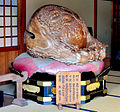- Wooden fish
-
 Wooden fish
Wooden fish
- "Muyu" redirects here. For the town in Shennongjia District, see Muyu, Hubei. For the overseas studies program, see Woodenfish.
A wooden fish (Chinese: 木魚, pinyin: mùyú), (Vietnamese: mộc ngư), (Japanese: mokugyo (木魚)), (Korean: moktak 목탁), (Tibetan: ཤིང་ཉ།, Wylie: shingnya) sometimes known as a Chinese block, is a wooden percussion instrument similar to the Western wood block[citation needed]. The wooden fish is used by monks and laity in the Mahayana Buddhist tradition. It is often used during rituals usually involving the recitation of sutras, mantras, or other Buddhist texts. The wooden fish is mainly used by Buddhist disciples in China, Japan, Korea, and other East Asian countries where the practice of Mahayana, such as the ceremonious reciting of sutras, is prevalent. In most Zen/Ch'an Buddhist traditions, the wooden fish serves to keep the rhythm during sutra chanting. In Pure Land Buddhism, it is used when chanting the name of Amitabha.
The Taoist clergy has also adapted the wooden fish into their rituals.
Contents
Types of wooden fish
There are two kinds of wooden fish. One is the traditional instrument that is round in shape and often made out of wood (often made out of lumber). The fish is hollow with a ridge outside of the wooden fish to help provide the genuine hollow sound when striking the fish (the instrument is similarly shaped like a jingle bell). The sound can differ amongst wooden fish depending on the size, type of wood used, and how hollow the wooden fish is. The instrument is carved with fish scales on its top, and a carving of two fish heads embracing a pearl on the handle (to symbolize unity), hence the instrument is called a wooden fish for that reason. In Buddhism the fish, which never sleeps, symbolizes wakefulness. Therefore, it is to remind the chanting monks to concentrate on their sutra. Often the mallet used to strike the fish has a rubber coated tip to provide a muffled, but clear sound when struck.
Wooden fish come in many sizes and shapes, ranging from 150 millimetres (5.9 in), for laity use or sole daily practice, or to 1.2 metres (3.9 ft) for usage in temples. Wooden fish are often (in Chinese temples) placed on the left of the altar, alongside a bell bowl, its metal percussion counterpart. Wooden fish often rest on a small embroidered cushion to prevent damage and unpleasant knocking sounds caused from the fish lying on the surface of a hard table or ground, as well as to avoid damage to the instrument.
Another type of wooden fish is literally in the shape of a fish. Along with a large temple bell and drum, It is found suspended in front of Buddhist monasteries. When proceeding with various duties (such as eating, lectures, or chores), a monk and a supervisor utilize the instrument to call all monastics to go to their tasks. Historically, this was the first wooden fish developed, which gradually evolved into the round wooden fish used by Buddhists today.
The Korean version of a wooden fish, or moktak, is simpler in shape and no design is carved onto the fish. The moktak is more oblong in shape. A handle is used for easy carrying for portable uses of the moktak. Moktaks are different in the sense that they provide a deeper, more wooden-like hollow sound when struck.
Legends & nomenclature
 A mendicant with a "wooden fish" (sitting in the middle, with a big hat), drawn by Johan Nieuhof between 1655-1658
A mendicant with a "wooden fish" (sitting in the middle, with a big hat), drawn by Johan Nieuhof between 1655-1658
Many legends describe the origin of the wooden fish - most take place in China and Korea. One says that a monk went to India to acquire sutras. On his way to India, he found the way blocked by a wide, flooding river. There appeared neither bridge nor boat[citation needed].
Suddenly, a big fish swam up. It offered to carry the monk across the river. The fish told the monk that it wanted to atone for a crime committed when it was a human. The fish made a simple request, that on the monk's way to obtain sutras, to ask the Buddha to guide the fish on a method to attain Bodhisattvahood.
The monk agreed to the fish's request and continued his quest for seventeen years. After getting the scriptures, he returned to China via the river, which was flooding again. As the monk worried about how to cross, the fish came back to help. It asked if the monk had made the request to the Buddha. To the monk's dismay, he had forgotten. The fish became furious and splashed the monk, washing him into the river. A passing fisherman saved him from drowning, but unfortunately the sutras had been ruined by the water.
The monk went home full of anger. Filled with anger at the fish, he made a wooden effigy of a fish head. When he recalled his adversity, he beat the fish head with a wooden hammer. To his surprise, each time he beat the wooden fish, the fish opened its mouth and vomited a character. He became so happy that, when he had time, he always beat the fish. A few years later, he had got back from the wooden fish's mouth what he had lost to the flood.
Use in the Chinese Orchestra
When used in the Chinese Orchestra, the wooden fish is often in sets of 5. It is commonly used to convey a solemn and religious feel to a piece. However, it has also been used in fast and lively pieces. An indefinite number of instruments may be used in a piece.
Gallery
-
One of the largest mokugyo in the world, located at Hasedera in Kamakura, Japan
External links
 Media related to Wooden fish at Wikimedia Commons
Media related to Wooden fish at Wikimedia CommonsBuddhism Traditional Chinese musical instruments Silk (string) Plucked Guqin · Se · Guzheng · Konghou · Pipa · Sanxian · Ruan · Liuqin · Yueqin · Qinqin · Duxianqin Bowed Huqin · Erhu · Zhonghu · Gaohu · Banhu · Jinghu · Erxian · Tiqin · Tihu · Yehu · Tuhu · Jiaohu · Sihu · Sanhu · Zhuihu · Zhuiqin · Leiqin · Dihu · (Xiaodihu · Zhongdihu · Dadihu) · Gehu · Diyingehu · Laruan · Matouqin · Yazheng Struck Yangqin · Zhu Bamboo (woodwind) Flutes Dizi · Xiao · Paixiao · Koudi Oboes Guan · Suona Free-reed pipes Bawu · Mangtong Gourd (woodwind) Sheng · Yu · Hulusi · Hulusheng Percussion Wood Muyu · Paiban · Guban Stone Bianqing Metal Bianzhong · Fangxiang · Luo · Yunluo Clay Fou Hide Daigu · Bangu · Paigu · Tanggu Others Xun · Gudi · Lusheng · Kouxian Traditional Japanese musical instruments String Plucked Biwa · Ichigenkin · Koto · Kugo · Sanshin · Shamisen · Yamatogoto · Tonkori Bowed Kokyū Wind Flutes Hotchiku · Nohkan · Ryūteki · Kagurabue · Komabue · Shakuhachi · Shinobue · Yokobue · Tsuchibue Oboes Hichiriki Free-reed pipes Shō · U Horns Horagai Percussion Drums Kakko · Taiko · (Ōtsuzumi · Shime-daiko · Tsuzumi) · Tsuri-daiko · Ikko · San-no-tsuzumi · Den-den daiko Blocks Hyōshigi · Mokugyo · Sasara · (Ita-sasara · Binzasara) · Kokiriko · Shakubyoshi · Sanba Gongs Shōko · Kagura suzu · Kane Others Mukkuri Categories:- Idiophones
- Chinese musical instruments
- Zen terms
- Buddhist ritual implements
Wikimedia Foundation. 2010.



